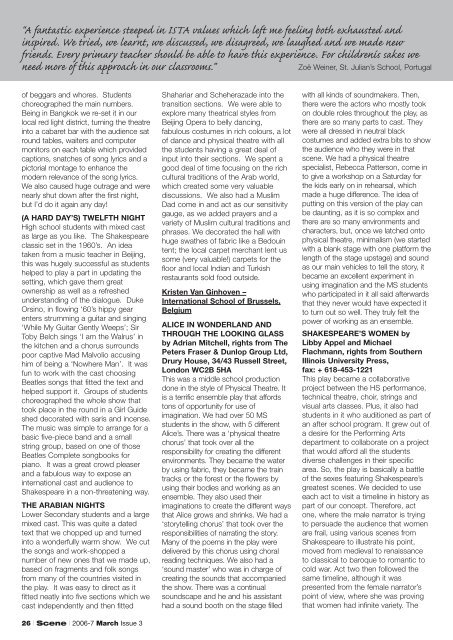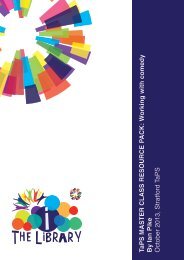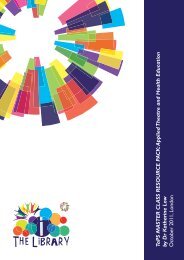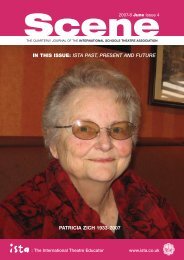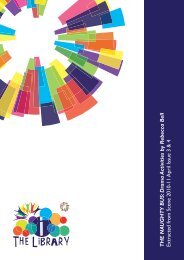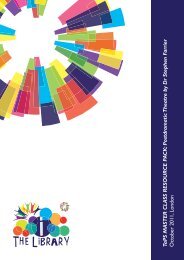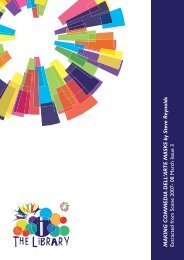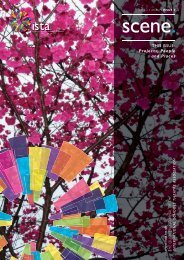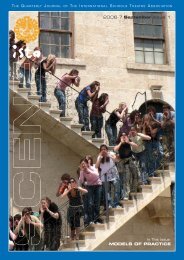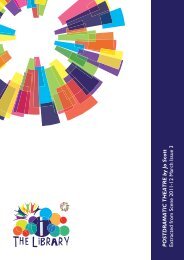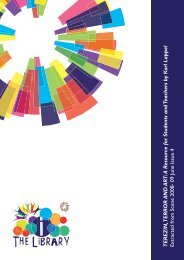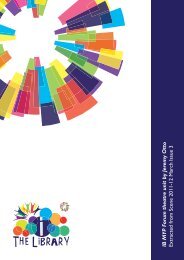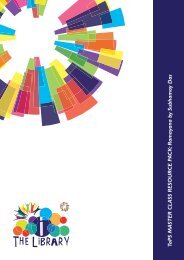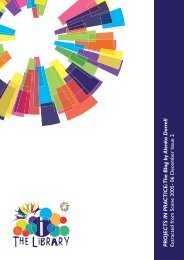ISTA/Scene March 07
ISTA/Scene March 07
ISTA/Scene March 07
Create successful ePaper yourself
Turn your PDF publications into a flip-book with our unique Google optimized e-Paper software.
“A fantastic experience steeped in <strong>ISTA</strong> values which left me feeling both exhausted and<br />
inspired. We tried, we learnt, we discussed, we disagreed, we laughed and we made new<br />
friends. Every primary teacher should be able to have this experience. For childrenís sakes we<br />
need more of this approach in our classrooms.”<br />
Zoë Weiner, St. Julian’s School, Portugal<br />
of beggars and whores. Students<br />
choreographed the main numbers.<br />
Being in Bangkok we re-set it in our<br />
local red light district, turning the theatre<br />
into a cabaret bar with the audience sat<br />
round tables, waiters and computer<br />
monitors on each table which provided<br />
captions, snatches of song lyrics and a<br />
pictorial montage to enhance the<br />
modern relevance of the song lyrics.<br />
We also caused huge outrage and were<br />
nearly shut down after the first night,<br />
but I’d do it again any day!<br />
(A HARD DAY’S) TWELFTH NIGHT<br />
High school students with mixed cast<br />
as large as you like. The Shakespeare<br />
classic set in the 1960’s. An idea<br />
taken from a music teacher in Beijing,<br />
this was hugely successful as students<br />
helped to play a part in updating the<br />
setting, which gave them great<br />
ownership as well as a refreshed<br />
understanding of the dialogue. Duke<br />
Orsino, in flowing ‘60’s hippy gear<br />
enters strumming a guitar and singing<br />
‘While My Guitar Gently Weeps’; Sir<br />
Toby Belch sings ‘I am the Walrus’ in<br />
the kitchen and a chorus surrounds<br />
poor captive Mad Malvolio accusing<br />
him of being a ‘Nowhere Man’. It was<br />
fun to work with the cast choosing<br />
Beatles songs that fitted the text and<br />
helped support it. Groups of students<br />
choreographed the whole show that<br />
took place in the round in a Girl Guide<br />
shed decorated with saris and incense.<br />
The music was simple to arrange for a<br />
basic five-piece band and a small<br />
string group, based on one of those<br />
Beatles Complete songbooks for<br />
piano. It was a great crowd pleaser<br />
and a fabulous way to expose an<br />
international cast and audience to<br />
Shakespeare in a non-threatening way.<br />
THE ARABIAN NIGHTS<br />
Lower Secondary students and a large<br />
mixed cast. This was quite a dated<br />
text that we chopped up and turned<br />
into a wonderfully warm show. We cut<br />
the songs and work-shopped a<br />
number of new ones that we made up,<br />
based on fragments and folk songs<br />
from many of the countries visited in<br />
the play. It was easy to direct as it<br />
fitted neatly into five sections which we<br />
cast independently and then fitted<br />
26 | <strong>Scene</strong> | 2006-7 <strong>March</strong> Issue 3<br />
Shahariar and Scheherazade into the<br />
transition sections. We were able to<br />
explore many theatrical styles from<br />
Beijing Opera to belly dancing,<br />
fabulous costumes in rich colours, a lot<br />
of dance and physical theatre with all<br />
the students having a great deal of<br />
input into their sections. We spent a<br />
good deal of time focusing on the rich<br />
cultural traditions of the Arab world,<br />
which created some very valuable<br />
discussions. We also had a Muslim<br />
Dad come in and act as our sensitivity<br />
gauge, as we added prayers and a<br />
variety of Muslim cultural traditions and<br />
phrases. We decorated the hall with<br />
huge swathes of fabric like a Bedouin<br />
tent; the local carpet merchant lent us<br />
some (very valuable!) carpets for the<br />
floor and local Indian and Turkish<br />
restaurants sold food outside.<br />
Kristen Van Ginhoven –<br />
International School of Brussels,<br />
Belgium<br />
ALICE IN WONDERLAND AND<br />
THROUGH THE LOOKING GLASS<br />
by Adrian Mitchell, rights from The<br />
Peters Fraser & Dunlop Group Ltd,<br />
Drury House, 34/43 Russell Street,<br />
London WC2B 5HA<br />
This was a middle school production<br />
done in the style of Physical Theatre. It<br />
is a terrific ensemble play that affords<br />
tons of opportunity for use of<br />
imagination. We had over 50 MS<br />
students in the show, with 5 different<br />
Alice’s. There was a ‘physical theatre<br />
chorus’ that took over all the<br />
responsibility for creating the different<br />
environments. They became the water<br />
by using fabric, they became the train<br />
tracks or the forest or the flowers by<br />
using their bodies and working as an<br />
ensemble. They also used their<br />
imaginations to create the different ways<br />
that Alice grows and shrinks. We had a<br />
‘storytelling chorus’ that took over the<br />
responsibilities of narrating the story.<br />
Many of the poems in the play were<br />
delivered by this chorus using choral<br />
reading techniques. We also had a<br />
‘sound master’ who was in charge of<br />
creating the sounds that accompanied<br />
the show. There was a continual<br />
soundscape and he and his assistant<br />
had a sound booth on the stage filled<br />
with all kinds of soundmakers. Then,<br />
there were the actors who mostly took<br />
on double roles throughout the play, as<br />
there are so many parts to cast. They<br />
were all dressed in neutral black<br />
costumes and added extra bits to show<br />
the audience who they were in that<br />
scene. We had a physical theatre<br />
specialist, Rebecca Patterson, come in<br />
to give a workshop on a Saturday for<br />
the kids early on in rehearsal, which<br />
made a huge difference. The idea of<br />
putting on this version of the play can<br />
be daunting, as it is so complex and<br />
there are so many environments and<br />
characters, but, once we latched onto<br />
physical theatre, minimalism (we started<br />
with a blank stage with one platform the<br />
length of the stage upstage) and sound<br />
as our main vehicles to tell the story, it<br />
became an excellent experiment in<br />
using imagination and the MS students<br />
who participated in it all said afterwards<br />
that they never would have expected it<br />
to turn out so well. They truly felt the<br />
power of working as an ensemble.<br />
SHAKESPEARE’S WOMEN by<br />
Libby Appel and Michael<br />
Flachmann, rights from Southern<br />
Illinois University Press,<br />
fax: + 618-453-1221<br />
This play became a collaborative<br />
project between the HS performance,<br />
technical theatre, choir, strings and<br />
visual arts classes. Plus, it also had<br />
students in it who auditioned as part of<br />
an after school program. It grew out of<br />
a desire for the Performing Arts<br />
department to collaborate on a project<br />
that would afford all the students<br />
diverse challenges in their specific<br />
area. So, the play is basically a battle<br />
of the sexes featuring Shakespeare’s<br />
greatest scenes. We decided to use<br />
each act to visit a timeline in history as<br />
part of our concept. Therefore, act<br />
one, where the male narrator is trying<br />
to persuade the audience that women<br />
are frail, using various scenes from<br />
Shakespeare to illustrate his point,<br />
moved from medieval to renaissance<br />
to classical to baroque to romantic to<br />
cold war. Act two then followed the<br />
same timeline, although it was<br />
presented from the female narrator’s<br />
point of view, where she was proving<br />
that women had infinite variety. The


